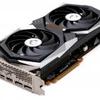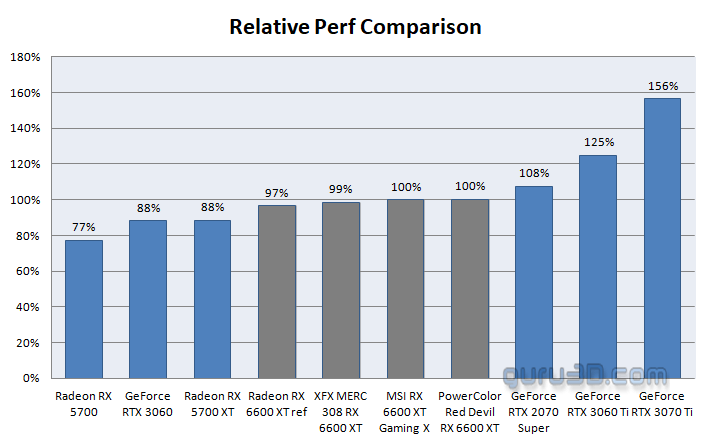Final words and conclusion
Final words
AMD has done really well with NAVI23, the GPU does as expected and even a little more, it really is a proper gaming card in that Full HD and even WQHD domain. But 379 USD for an entry-level to mainstream level graphics card, holy bejeezus, how times have changed. Too expensive? Yeah, we think so. The cards sits close to RTX 3060 and 5700 XT performance, but only in shading performance. Raw Raytracing performance is a notch slower than the competition offers. Albeit FSR is now available to help a little bit, we can also not apprehend that AMD still has not implemented any form of machine learning super-sampling dedicated in hardware, much like NVIDIA offers Tensor cores. For reasons like RT perf and lacking MLAA, we cast doubt on how AMD is justifying that starting price of 379 USD. You can also argue that while the Infinity cache works most of the time, it's designed to be a workaround to fill an imperfection (128-bit memory bus) and the choice of a more affordable memory type (GDDR6 opposed to GDDR6X), the current AMD GPUs are very memory bandwidth deprived, even with GDDR6 at 16 Gbps, but more so due to the 128 -bit wide memory bus. And that's going to bite this product in the ass every time you get GPU limited, or the32MB L3 cache runs out and gets fewer hits.
FidelityFX Super Resolution
AMD has been implementing its own DLSS counterpart called FidelityFX Super-Resolution for a while. The supersampling and sharpening technology from AMD is available however the number of games that support is incredibly poor. As you have been able to see, we tested this at the latest iteration of Resident Evil as it's really the only AAA title that has support, and the increase in perf was okay at best combined with Raytracing.
Performance spread reference
Check out the following comparison of different graphics cards that are in a selected price-performance range: Take a look at the table below to see how the differences are not noticeable from top to bottom. For this week we have three 6600 XT products lined up (two other AIB cards will go live tomorrow). Unfortunately, AMD does not offer a reference card, ergo we downclocked the 6600 XT entry towards reference values. While these are not delivering precise values we estimate that the difference between reference and the factory tweaked models tested is roughly 3%. In between the three cards tested the performance differential is 1% or less. That said, please look at the next plot:
If we look at the data in further detail, we can see something interesting. Specifically, AMD is aiming the 6600 XT against the GeForce RTX 3060, which has an MSRP of 329 USD and a similar feature set. AMD, on the other hand, has set an MSRP of 379 USD. The 3060 Ti, on the other hand, costs 399 USD. As a result, the Radeon RX 6600 XT is, in our perspective, competitively priced with the 3060 Ti and not 3060, despite being substantially less powerful.
Cooling & acoustic
The MSI Gaming X Radeon RX 6600 XT, like its larger brothers, delivers excellent performance even under demanding situations, thanks to the dual-fan cooling. If you try to hear the card, you'll have a difficult time. According to its default configuration, the GPU beneath the hood generates 160W~170 of heat, suggesting that the cooler has a thermal power design of 250 W. We're looking at 32~33 DBa values under load and temperatures in the 60-65 degree Celsius range, which are both just ideal. Additionally, a board examination reveals that all important components are linked to some sort of cooling. FLIR imaging reveals that the card is only barely leaking heat. In general, we are really satisfied with what we have observed.
Energy
Heat output and energy consumption are closely related to each other, as (graphics) processors and heat can be perceived as a 1:1 state; 250 Watts in energy consumption approaches close to 250 Watts in heat as output. This is the basis of TDP. AMD is listing the card at 160W, which is okay at best for a graphics card in the year 2021. We measure numbers slightly under the XT's advertised values; we measure the entire power consumption of the card to close in at 160~170 Watt.
Coil whine
Coil squeal is present on the 6600 XT, just as it is on any other card these days, albeit to a smaller extent than usual. Is it a bothersome annoyance? It is, without a doubt, at a volume that is difficult no concern. This type of noise would be muffled in a closed chassis and fade into the background. With an open chassis, on the other hand, you may hear coil whine/squeal. In some way or another, all graphics cards do this, especially when running at higher frame rates; this can be perceived.
Pricing
The 6600 XT is priced significantly higher than it should be, in our opinion, and we have already discussed this extensively. AIB devices will almost certainly exceed the 400 USD level, which makes little sense for a product geared at the Full HD monitor market and fighting against a 399 USD GeForce RTX 3060 Ti. We truly believe that this device should cost no more than 279 USD at the most.
Tweaking
The RX 6600 XT enjoys having more memory bandwidth available to it. You can add it manually and get up to 18 or if you are lucky 19.2 Gbps; however, results will vary depending on the board, brand, and even card due to cooling (GDDR6/GPU/VRM) and other factors. With a little GPU tweaking, we could get this AMD Navi GPU to run at a very respectable 2700~2800 MHz. And that's without any anomalies or crashes of any kind. The dynamic clock frequency is now hovering in the 2750 MHz range, depending on the load, game/app, and board assigned power. Even so, that's quite a feat. As is always the case, all of your tweaking and increased energy consumption will only provide you with a maximum of 5~7% improvement in performance (depending on your results and model graphics card). It must successfully complete four-game runs (in four different games) in 2560x1440 resolution in order to be considered stable enough to be listed here.
Conclusion
The base design of the RX 6600 XT is sound; AMD has made decisions in the memory subsystem that have limited memory bandwidth; by including 32MB of L3 cache, they have bypassed the majority of that challenge, and the card performs flawlessly up to 1920x1080; however, L3 cache will always be a bypass, a shortcut solution to a problem that may recur in the future. Because of the extremely limited memory bus, performance will suffer as soon as the cache fails to respond. The performance of AMD's raytracing technology is not on par with its competitors, but it is still usable for "fooling around a little." We don't believe FSR will be sufficient for most AAA games to make a significant enough difference in this area as 1080P is the gaming domain for this card, and FSR works better at higher resolutions. It has to be stated, it is a fun option to have and experiment with though. If the price weren't so exorbitant, this would still be an appealing and beautiful product in the 1920x1080 resolution; but, the price is just that, too excessive. At the absolute least, the product would have had to be priced below the $300 USD barrier to qualify for consideration. I understand that you can disagree and dispute with me. Occasionally, the card is as fast as or slightly faster than an RTX 3060 or closer to the Ti. The product is priced close to the $399 3060 Ti. For games that support DLSS, however, Geforce 3060 Ti is the clear winner in every situation. And for that 20 bucks more that card will perform roughly 25% better as well. To summarize, the Radeon RX 6600 XT series continues to be a fun gaming card series that is purely focused on rasterized shading; at Full HD and even WQHD resolutions, the 32MB L3 cache works its magic. You can experiment a little bit with raytracing to see what happens. The high asking price, though, continues to be a major concern especially when you weigh in product positioning and relative performance. MSI on their end did an excellent job with the Gaming X design and did things right; you will receive a device that is silent, stylish, and hip-looking.
Sign up to receive a notification when we publish a new article.
Or go back to Guru3D's front page.
- Hilbert, LOAD"*",8,1.


